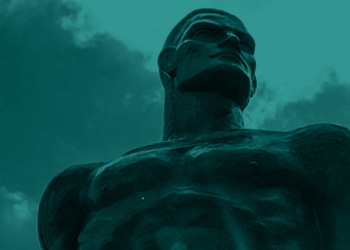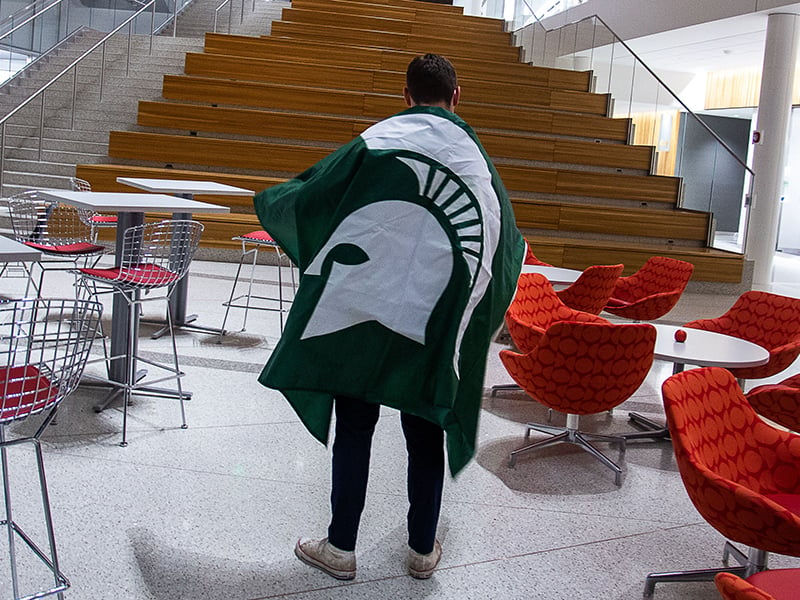Feature: Lighthouse Keepers at MSU's Library

LIGHTHOUSE KEEPERS AT MSU'S LIBRARY
'With knowledge doubling every three-and-a-half to four years, the library has become the intellectual lighthouse, the focal point of the campus.' -- David Scott, MSU Provost
Every year more than two-and-a-half million students, faculty, alumni and plain ordinary citizens from over a hundred countries enter the Michigan State University Libraries. To give you a better idea of that number, imagine 167 sell-out Breslin Centerfuls or 33 Spartan Stadiumfuls of inquisitive readers walking over the teal and burgundy wall-to-wall carpeting in search of pleasure and information, of sweetness and light. Beyond the sheer numbers, what's really exciting is that the MSU Libraries are on the move. They have been acquiring the latest technology, augmenting their services with creativity, and, despite growing volumes, becoming more and more user-friendly.
Indeed, alumni who have not visited their former studying place in a while will find some awesome changes. More than 95 percent of the Libraries' three and a half million volumes have been automated onto the machine-readable NOTIS and MAGIC formats thanks to a $900,000 grant from the Kellogg Foundation. Faculty who are set up for it can now access library collections from their offices or labs, and students can find library holdings from their dormitories. The technological revolution is well on its way.
British philosopher Thomas Carlyle once defined a university as a collection of books. No one can imagine a university without a library, and Vanderbilt University Provost Charles Kiesler, an alumnus of MSU and a member of the Libraries' Board of Visitors, points out that 'No one can imagine a great university without a great library.'
Fortunately, his alma mater has such a library, one that ranks among the top 35 research libraries in America and one whose unique collections in such diverse areas as cookbooks, apiculture, the French monarchy, fencing, comic books and voices are unparalleled anywhere in the world. Those of you who are members of the MSU Alumni Association can use the facilities as part of your membership benefits. Sharing MSU's riches with other libraries and sharing in their unique holdings is one of the challenges of a future where new scholarly publications are burgeoning, where the cost of academic literature has doubled in the last decade and where in the next decade about one fourth of all research collections may be lost unless measures are taken to preserve them. Libraries can no longer afford to duplicate each others' holdings and are taking steps to join into statewide super-libraries to ensure all readers have access to all materials.
It's a brave new world and a fascinating one. Just how much so? Alumni can find out this Homecoming Weekend (October 3-4) when the Libraries will entertain hundreds of Spartans at the Second Annual Library Open House. If it is anything like the 1991 Open House, people can expect to take free private lessons in the MAGIC and CD-ROM technologies and to take a magical mystery tour of a library they might not remember: a library with a cafeteria and carpeting and banks of television sets, a library where MAGIC computer terminals and CD- ROMs have replaced the card catalog.
The following month (Nov. 6-7) the Libraries invite everybody back for the first annual Michigan Writers Program, the brainchild of Special Collections librarian Peter Berg, who has been collecting sedulously the works of authors with MSU connections. This first forum will bring together Jim Harrison, Dan Gerber, Richard Ford and Ted Wessner for the first time since they went their separate ways to win national recognition as literary figures. The first program in this annual series will allow them to mingle with one another and with fellow Spartans new and old and to talk about life and literature and to read from their works. The library, whose function it is to conserve as well as to liberate, will record the proceedings for the voice library collection and will also print them, along with written statements by the participants, in a limited edition by the university press to be distributed to the speakers, to special collections, and to collectors, bibliophiles, and members of the newly reborn Friends of the Library.
In the spring, the Libraries will host the third annual Great American Readaloud in connection with National Library Week. The one-day Readaloud of April 17, 1991 was expanded this year into a week long program under the 1992 National Library Association theme 'Your Right to Know.' A Sunday reception on April 5 was followed by five 'theme days,' on Cracking The Code (using Braille and American Sign Language, etc.), Diversity, Banned Books, Nature and the Environment, and Government, and involved the mayor and leading citizens of the community as well as the president and university faculty as readers.
Every week of the academic year the Library Seminar Series offers the university community a chance to study a new subject in small, intimate sessions. Last year these ranged from collecting African art to obtaining grants in a half dozen different disciplines; from the esoteric and scholarly to the immediate and practical, these seminars display the variety of talents and areas of expertise of the library staff. Talents also shine in the flurry of homegrown media coming out of the library these days; there is the issue-oriented University Libraries Newsletter and the semiannual broad-scope insert in the News-Bulletin. In graphics, the two Welcome Week posters have won successive annual Addy Awards from the National Advertising Federation; next year the library will try for three in a row.
These handsome and informative posters, distributed free to all comers, currently grace the walls of dormitories, schools and libraries throughout the land. A new motion picture short is also being readied for distribution this year. And, importantly for Hiram Davis' administrative philosophy, there is Library Link, heir to the original Visions of the Future, offering library staff a forum for communicating with one another and for directing their own destiny. It didn't take long for the university to recognize that two of Hiram Davis' favorite words are 'stakeholder' and 'empowerment' and that his favorite concept is 'stakeholder empowerment.' He arrived on campus on October 1, 1989, and by the time November 1 rolled around, University Libraries had already begun a campus-wide strategic planning process, seeking input from every corner of the community on ways to improve the environment, the holdings and the operations of the 'lighthouse.'
As the data poured in, committees began to sort requests, suggestions and demands into piles marked Long-range, Ongoing and Immediate. For the first time, the entire library staff was invited to partake in administrative decision making through a series of long 'retreats' that had all the characteristics of 'advances.' There were huge town meetings stimulated by out-of-town speakers, enthusiastic librarians from places very much like Michigan State, who came to share war stories of struggle and success in restructuring their own institutions. They included Sheila Creth, who revised the library at the University of Iowa; Paul Mosher, vice provost and director of libraries; and Patricia Renfro, associate director of libraries at the University of Pennsylvania; John Tyson, state librarian of Virginia; Jeffrey Gardner, director of the Association of Research Libraries' (ARL) office of management services; Duane Webster, executive director of the ARL; and Barbara von Wahlde, associate vice president for libraries at the State University of New York at Buffalo.

